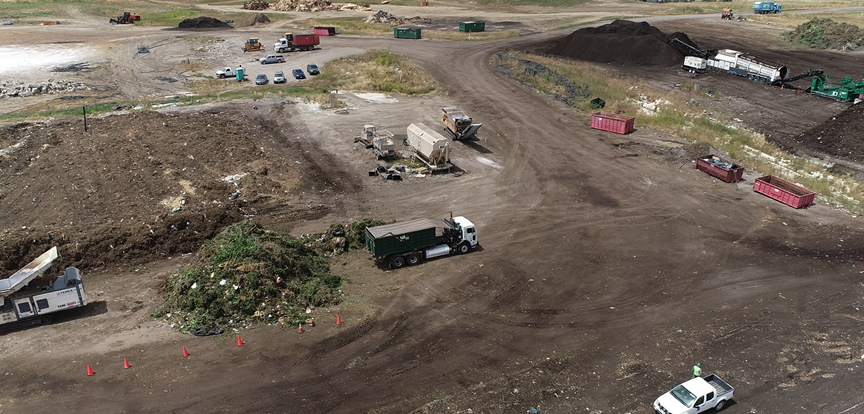
From Your Organic Waste Bin to Compost
Introduction
Landfills are the third largest source of methane in California, contributing 20% of greenhouse gas emissions to the atmosphere (source: California Air Resources Board). In 2016, Senate Bill 1383 was introduced to reduce methane emissions by decreasing organic waste disposal and increasing food recovery of surplus food. Because organic waste in the landfill emits a large portion of methane, targeting organic waste is an effective way to combat the climate crisis (source: CalRecycle). Instead, Californian’s now toss their food waste in the designated organics bin to divert organic waste from the landfill to reach the goals set in SB 1383.
But what happens to this organic waste once it’s picked up? With mandatory organics collection now in place, proper recycling facilities have become essential. An example of a composting plant is the Yolo County Landfill’s Anaerobic Composting facility, located less than 20 miles from Sacramento. Unlike most facilities, the Yolo County Landfill is publicly owned and operated, prioritizing community access and environmental responsibility. This facility reduces waste in multiple ways from salvaging usable items and redistributing them to the community to composting organic waste. Here, anaerobic composting is utilized to process organic material, reduce methane emissions, and ultimately transform waste into reusable, nutrient-rich compost. Currently, much of Sacramento County and the City of Sacramento’s organic waste is sent to this facility (source: Yolo County Landfill).
Experience at Yolo County Central Landfill
This past September, BREATHE’s Food Scraps and Recycling team had the opportunity to tour the Yolo County Central Landfill’s composting facility, gaining a firsthand look at the journey of Sacramento residents’ organic waste. Our team was guided by Pam Hedrick, Yolo County’s Waste Reduction & Recycling Coordinator. We explored how the Yolo County Landfill has developed to become a multi-functional hub for waste reduction.
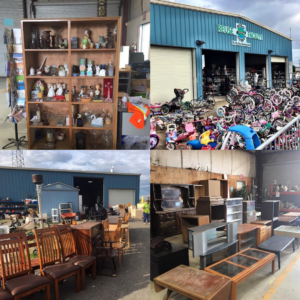
The Yolo facility has operated for over 49 years and responsibly processes a diverse range of waste materials from the community, including: household items, construction debris, organic waste, electronics, and hazardous waste. The landfill not only disposes of waste but also promotes waste reduction by salvaging usable items, such as furniture, and selling them through its on-site thrift store, Big Blue Barn. Along with the thrift store, the Yolo County Central Landfill offers free paint and other reusable household products (source: Yolo County – Household Hazardous Waste). This facility has taken the initiative for waste reduction efforts all around. According to Pam Hendricks, they got an early start on composting projects to prepare for the changes in waste disposal prior to the passage of SB 1383. With the passage of this bill, the Yolo County Landfill has expanded exponentially, meeting increased demand and helping California stay on track with its climate action goals.
Composting at Yolo County Central Landfill
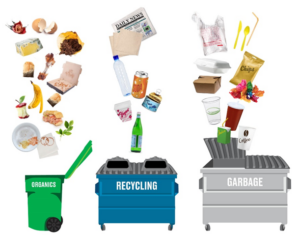
Effective composting starts with properly sorting waste, as it plays a significant role in the process. What can be composted is typically anything that is not plastic, metal, painted, or chemically treated. Common compostable items include organic waste like fruits and vegetables (including pits, shells, and skins), meats and bones, eggshells, as well as napkins and unlined paper plates/cups. Generally, if it’s edible, it can be composted! However, certain items are not acceptable for composting, such as plastic waste, Styrofoam, metal cans, aluminum foil, diapers, hazardous waste, and pet waste. Always double-check if you’re uncertain! It is important to note that this facility does not inspect the waste, so it’s essential to ensure you are sorting correctly.
At the Yolo County Landfill, organic materials are processed at the Anaerobic Composting Facility (Compost Facility 1). Each year, this facility manages around 52,000 tons of organic waste. This large volume of green waste undergoes a two-phase treatment: anaerobic digestion in the first phase, lasting 20 to 22 weeks, followed by a shorter aerobic composting period of about 2 weeks. During the first phase, methane is produced and captured for use in the facility’s power generation. Once the aerobic phase is complete, the resulting material is sorted to remove any non-compostable items. To ensure quality, the final compost undergoes testing according to TMECC (Test Methods for the Examination of Composting and Compost) standards by a certified lab. This testing checks key parameters such as carbon-to-nitrogen ratios and organic matter content to guarantee safety and quality before it is made available to the public.
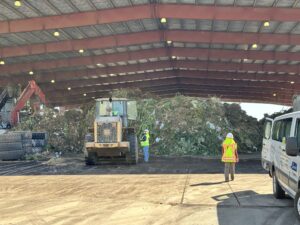
At Compost Facility 2, known as the Covered Aerated Static Pile (CASP), the same organic materials are processed using a different method. This facility began operations in July 2022 and has an annual capacity of 183,000 tons of organic waste. Unlike the anaerobic process, the CASP does utilize oxygen through positive aeration, with 6,336 holes in the concrete allowing air to flow upward through the compost pile. A biofilter made of mature compost or wood chips insulates the pile, retains heat, captures air emissions, and controls odors. The process begins with bringing feedstock to the landfill, followed by grinding the organic waste. The material is then placed in the CASP for an active phase of 22 days. After this phase, it is removed and cured for an additional 40 days. The CASP process transforms organic material into compost for customer use within 62 days.
(Source: Yolo County Central Landfill – Composting)
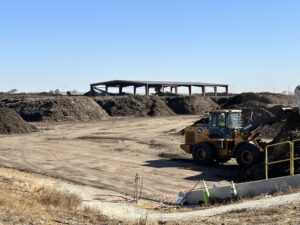
The Yolo County Landfill demonstrates how public facilities can lead the way in greener practices by embracing innovative waste management solutions and community-focused services. Through anaerobic composting and the CASP system, the landfill not only helps reduce methane emissions but also creates compost that enriches soils. Additionally, by salvaging usable items and redistributing them through the Big Blue Barn thrift store and public hazardous waste exchange, the landfill actively works to minimize waste and give materials a second life.
The success of Yolo County’s approach highlights the power of collective action in tackling climate change. As California continues its path toward reducing landfill emissions, communities play a crucial role in waste sorting and responsible disposal. Each time we place food scraps, yard waste, and compostables in the right bin, we help facilities like Yolo County Landfill enhance their effectiveness in achieving sustainability goals.
Authors: Sharon Kaur, Paige Arnett, Melissa Hill, Rose Peng, Kassandra Vega